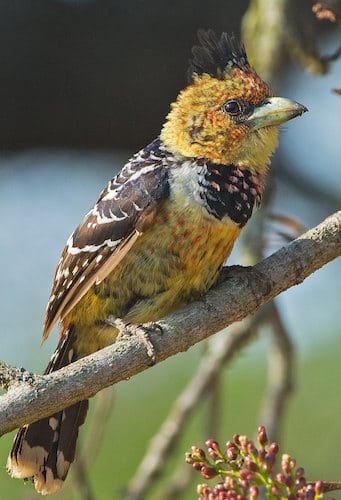Lybiidae – African Barbets

The Lybiidae or African barbets are a family of near passerine birds confined to Africa. They were usually united with their American and Asian relatives in the Capitonidae for quite some time. The species range from the type genus Lybius of forest interior to the tinkerbirds (Pogoniulus) of forest and scrubland. They are found throughout sub-Saharan Africa, with the exception of the far south-west of South Africa.
The African terrestrial barbets, Trachyphoninae, range from the southern Sahara to South Africa. Members of one genus, Trachyphonus, they are the most open-country species of barbets. The subfamily Lybiinae contains the African arboreal barbets.
Most African barbets are about 20cm to 25cm long, plump-looking, with large heads, and their heavy bill is fringed with bristles; the tinkerbirds are smaller, ranging down to the Red-rumped Tinkerbird at 7g and 9cm. They are mainly solitary birds, eating insects and fruit. Figs and numerous other species of fruiting tree and bush are visited, an individual barbet may feed on as many as 60 different species in its range. They will also visit plantations and take cultivated fruit and vegetables. Fruit is eaten whole and indigestible material such as seed pits regurgitated later (often before singing). Regurgitation does not usually happen in the nest (as happens with toucans), although tinkerbirds do place sticky mistletoe seeds around the entrances of their nests, possibly to deter predators. As the other barbets, they are thought to be important agents in seed dispersal in tropical forests.
As well as taking fruit, African barbets also take arthropod prey, gleaned from the branches and trunks of trees. A wide range of insects are taken, including ants, cicadas, dragonflies, crickets, locusts, beetles, moths and mantids. Scorpions and centipedes are also taken, and a few species will take small vertebrates such as lizards, frogs and geckos.
The precise nesting details of many African barbets are not yet known, although peculiarly among the Piciformes, some sociable species will nest in riverbanks or termite nests. Like many members of their order, Piciformes, their nests are in holes bored into a tree, and they usually lay between 2 and 4 eggs (except for the Yellow-breasted Barbet which lays up to 6), incubated for 13 to 15 days. Nesting duties are shared by both parents.
According to the IOC, there are 42 species of African Barbet, which are:
Grey-throated Barbet Gymnobucco bonapartei
Sladen’s Barbet Gymnobucco sladeni
Bristle-nosed Barbet Gymnobucco peli
Naked-faced Barbet Gymnobucco calvus
White-eared Barbet Stactolaema leucotis
Whyte’s Barbet Stactolaema whytii
Anchieta’s Barbet Stactolaema anchietae
Green Barbet Stactolaema olivacea
Speckled Tinkerbird Pogoniulus scolopaceus
Green Tinkerbird Pogoniulus simplex
Moustached Tinkerbird Pogoniulus leucomystax
Western Tinkerbird Pogoniulus coryphaea
Red-rumped Tinkerbird Pogoniulus atroflavus
Yellow-throated Tinkerbird Pogoniulus subsulphureus
Yellow-rumped Tinkerbird Pogoniulus bilineatus
White-chested Tinkerbird Pogoniulus makawai
Red-fronted Tinkerbird Pogoniulus pusillus
Yellow-fronted Tinkerbird Pogoniulus chrysoconus
Yellow-spotted Barbet Buccanodon duchaillui
Hairy-breasted Barbet Tricholaema hirsuta
Red-fronted Barbet Tricholaema diademata
Miombo Pied Barbet Tricholaema frontata
Acacia Pied Barbet Tricholaema leucomelas
Spot-flanked Barbet Tricholaema lacrymosa
Black-throated Barbet Tricholaema melanocephala
Banded Barbet Lybius undatus
Vieillot’s Barbet Lybius vieilloti
White-headed Barbet Lybius leucocephalus
Chaplin’s Barbet Lybius chaplini
Red-faced Barbet Lybius rubrifacies
Black-billed Barbet Lybius guifsobalito
Black-collared Barbet Lybius torquatus
Brown-breasted Barbet Lybius melanopterus
Black-backed Barbet Lybius minor
Double-toothed Barbet Lybius bidentatus
Bearded Barbet Lybius dubius
Black-breasted Barbet Lybius rolleti
Yellow-billed Barbet Trachyphonus purpuratus
Crested Barbet Trachyphonus vaillantii
Red-and-yellow Barbet Trachyphonus erythrocephalus
Yellow-breasted Barbet Trachyphonus margaritatus
D’Arnaud’s Barbet Trachyphonus darnaudii
-
Bearded Barbet Lybius dubius
Species AccountSound archive and distribution map. -
Bearded Barbet Lybius dubius
Species AccountThe bearded barbet (Lybius dubius) is an African barbet. Barbets and toucans are a group of near passerine birds with a worldwide tropical distribution. The barbets get their name from the bristles which fringe their heavy bills. -
Crested Barbet Trachyphonus vaillantii
Species AccountSound archive and distribution map. -
Crested Barbet Trachyphonus vaillantii
Species AccountThe crested barbet (Trachyphonus vaillantii) ('trachys'=rough, 'phone'=voice, sound') is a sub-Saharan bird in the Lybiidae family. Its specific name commemorates François Levaillant, a famed French naturalist. -
D'Arnaud's Barbet Trachyphonus darnaudii
IUCN Species Status -
D'Arnaud's Barbet Trachyphonus darnaudii
Species AccountSound archive and distribution map. -
D'Arnaud's Barbet Trachyphonus darnaudii
Species AccountD'Arnaud's barbet (Trachyphonus darnaudii) is an African barbet. Barbets and toucans are a group of near passerine birds with a worldwide tropical distribution. The barbets get their name from the bristles which fringe their heavy bills. Four geographical races (darnaudii, böhmi, emini and usambiro) have been recorded. -
Yellow-breasted Barbet Trachyphonus margaritatus
IUCN Species Status -
Yellow-breasted Barbet Trachyphonus margaritatus
Species AccountSound archive and distribution map. -
Yellow-breasted Barbet Trachyphonus margaritatus
Species AccountThe yellow-breasted barbet (Trachyphonus margaritatus) is a species of bird in the Lybiidae family. It is found in Burkina Faso, Chad, Djibouti, Eritrea, Ethiopia, Mali, Mauritania, Niger, Nigeria, Somalia, and Sudan.
-
Number of bird species: 42
-
Toucans, Barbets and Honeyguides
by Lester Short and Jennifer Horne, Illustrated by Albert Earl Gilbert ? Part of the Bird Families of the World series published by Oxford University Press http://www.oup.com
See Fatbirder Review ISBN: 0198546661 Buy this book from NHBS.com
